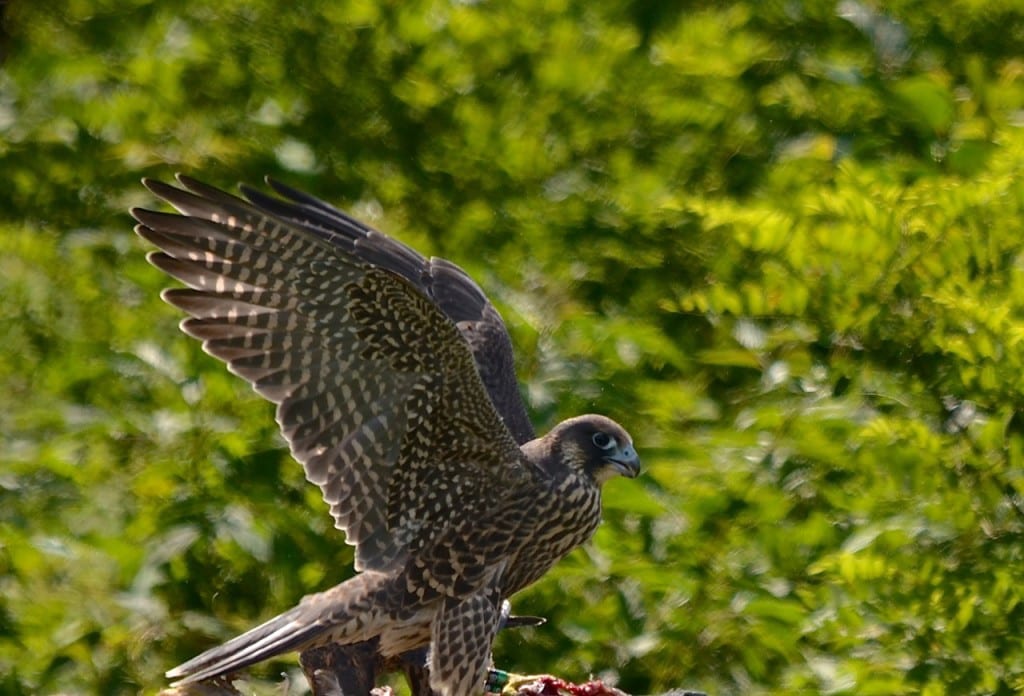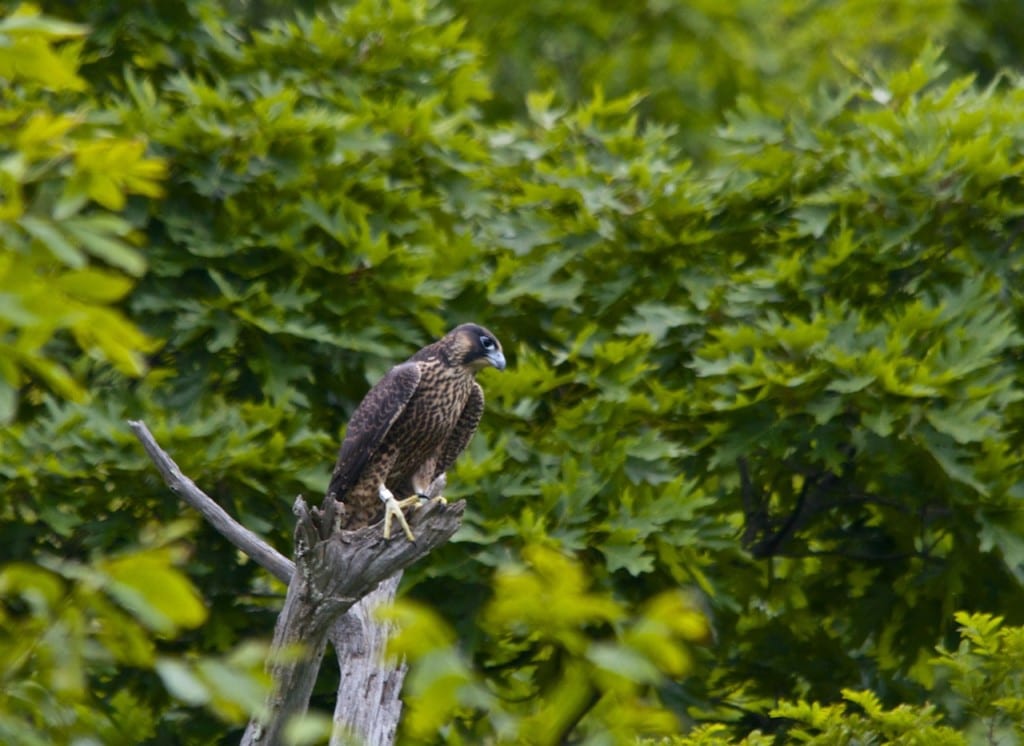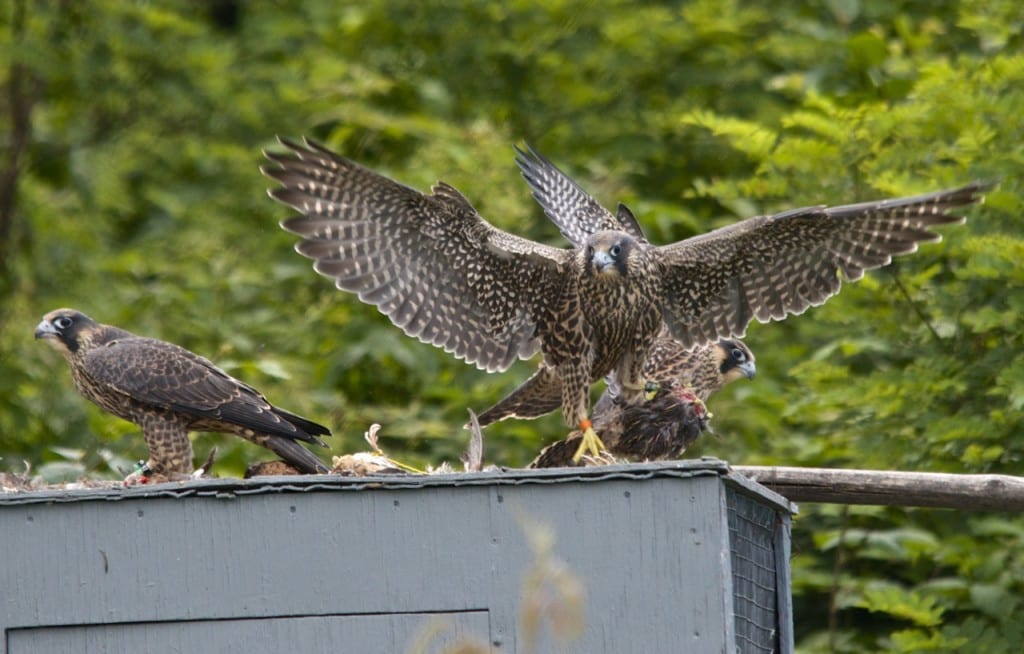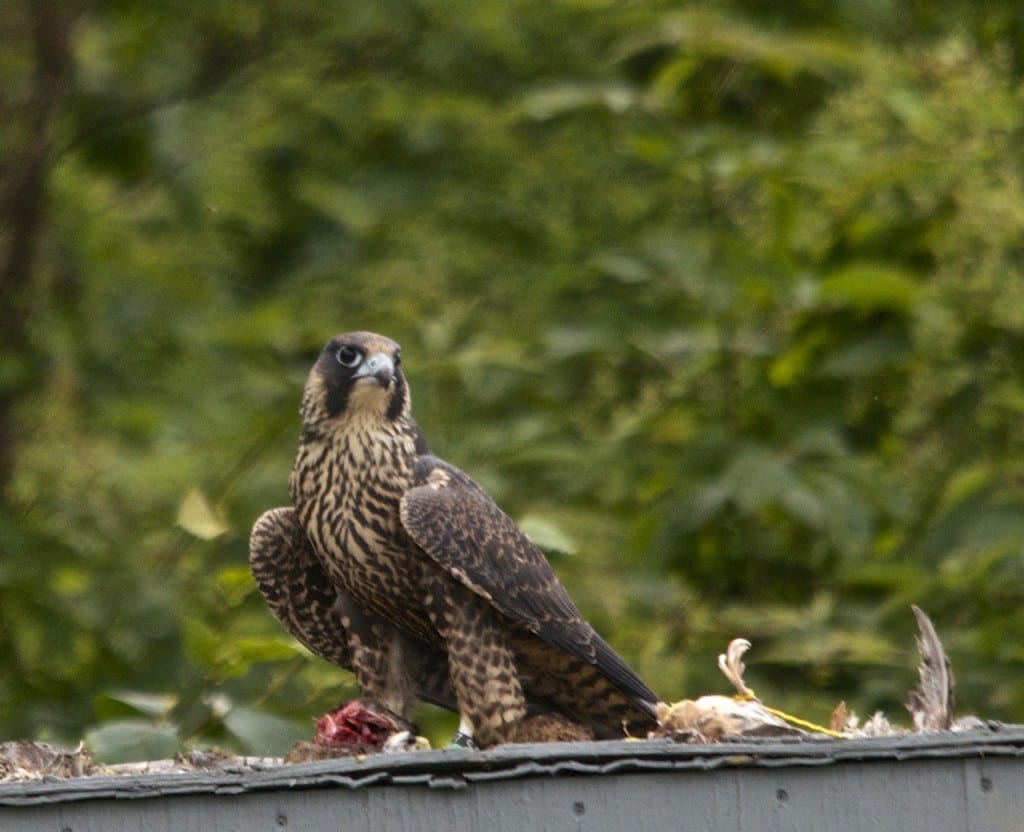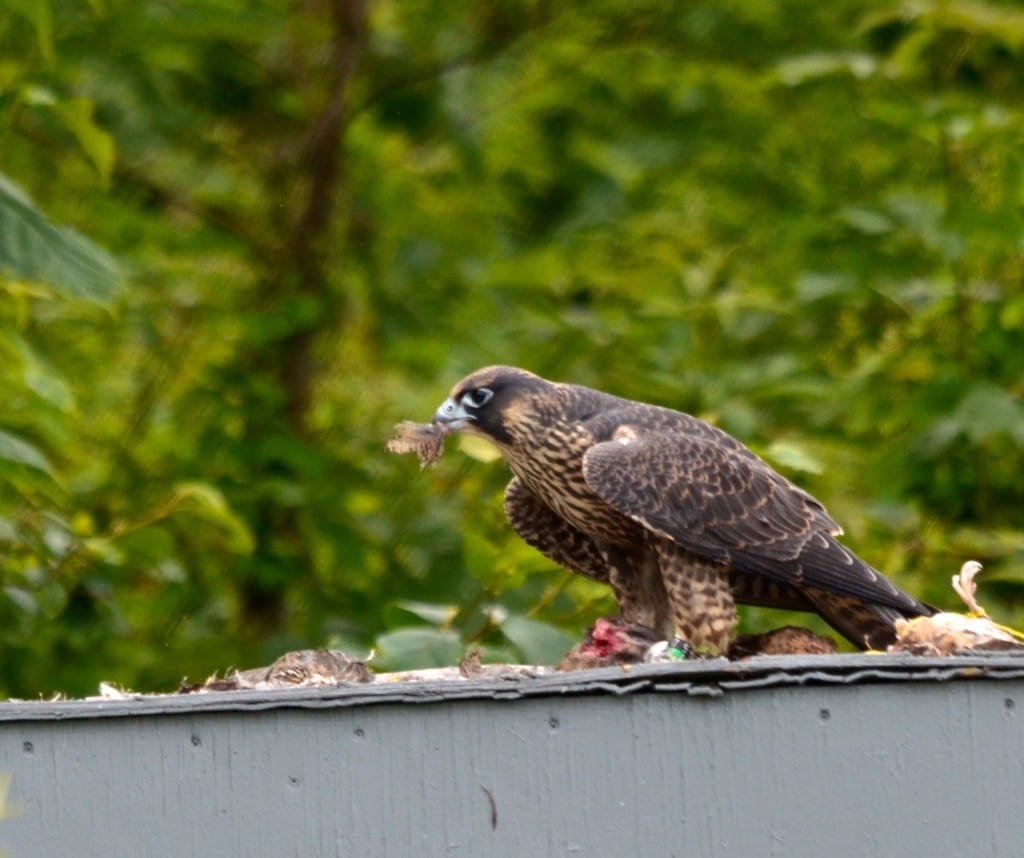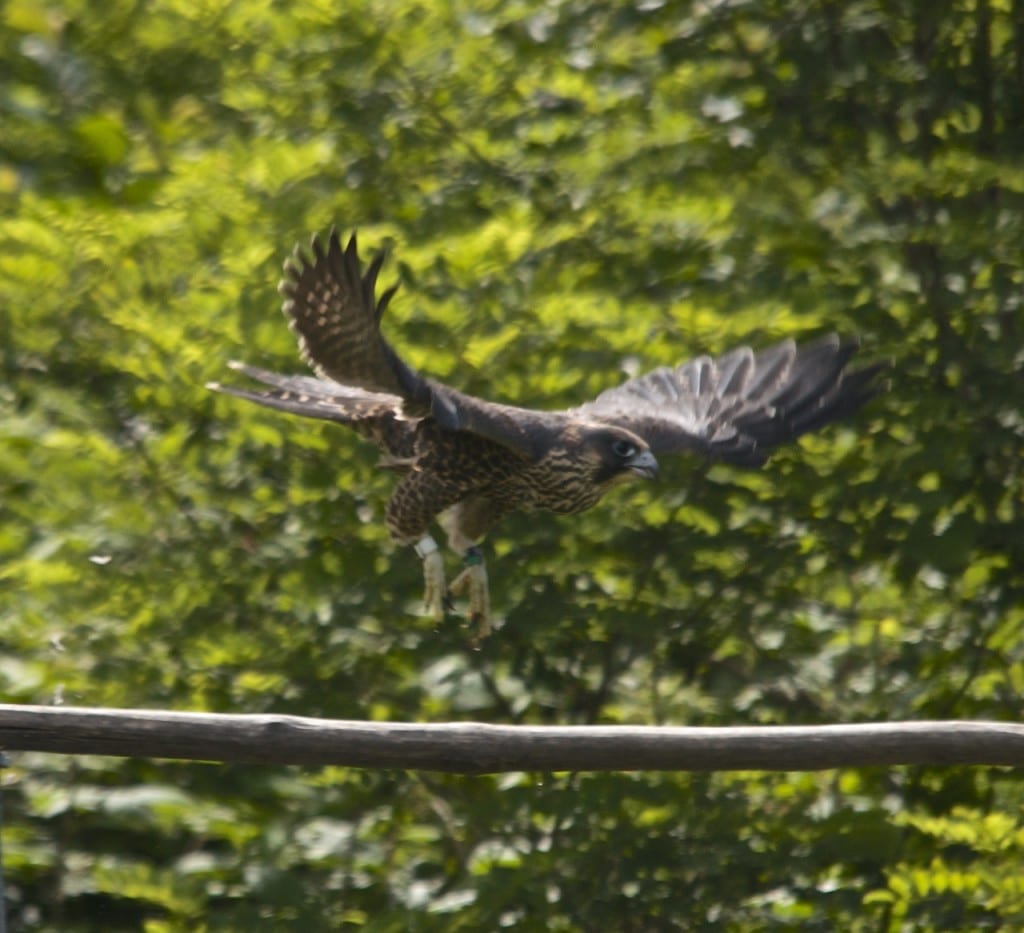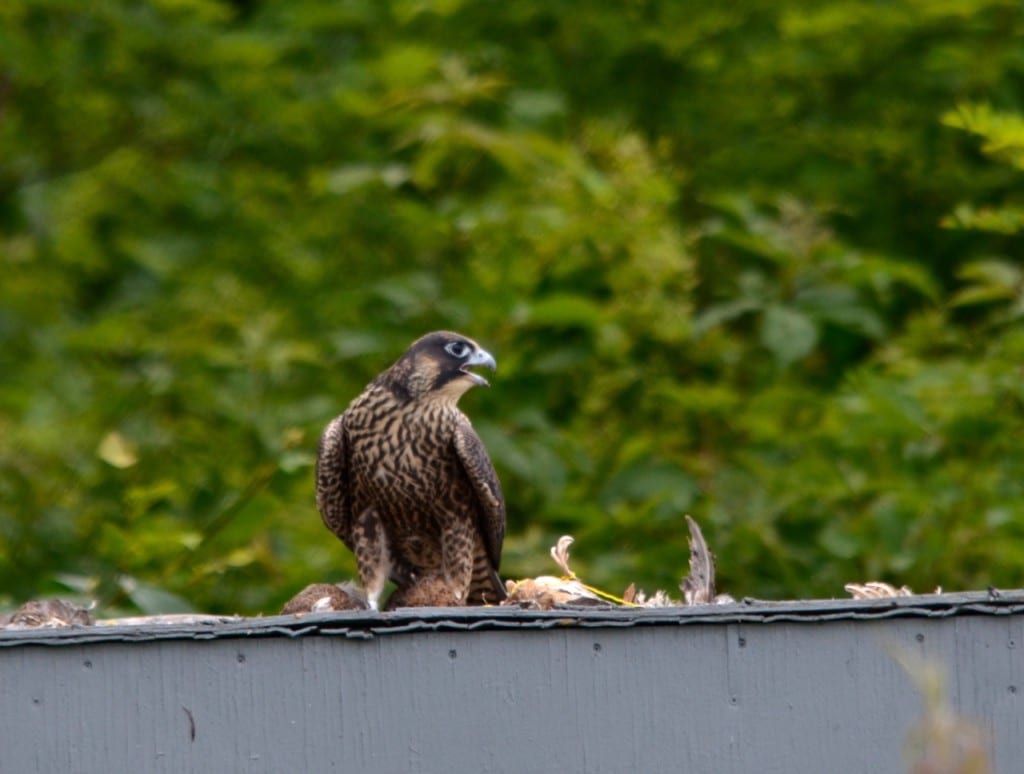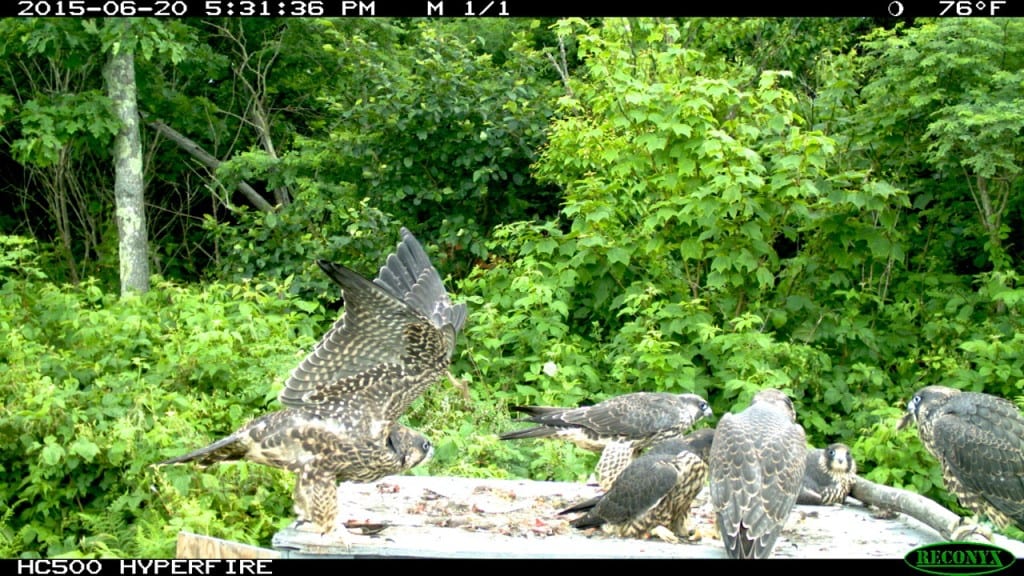By Glynn Wilson –
HOGBACK MOUNTAIN, Va. – It’s officially summer now in the Shenandoah National Park, although you wouldn’t know it from the cool nighttime temperatures in the mountains, compared to the rest of the South. But it’s true. The summer solstice occurred Sunday, the longest day of the year.
For a few weeks I’ve been trying to find the time and the right weather conditions to visit the park’s peregrine falcon hack site north of the Mathews Arm Campground. I had an appointment to do this a couple of weeks back but we ended up in the clouds again, the fog too thick to see far enough to shoot pictures of the great birds.
After a slow start Monday morning, I finally headed north on Skyline Drive from Big Meadows and found the service road by the Hogback Mountain Overlook and parked. Just a short distance up the road, the Appalachian Trail picked up and I headed into the woods, passing a few AT hikers and backcountry campers along the way, some headed for Front Royal and other points north. One said he was headed all the way to Maine, an ambitious undertaking to say the least.
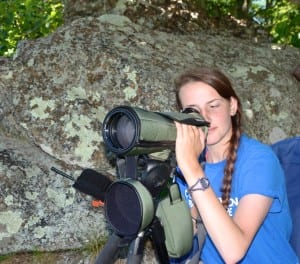
Peregrine falcon restoration program intern Claire Hartl watching peregrine falcons through a Nikon scope in Shenandoah National Park: Glynn Wilson
Rounding a bend in the trail, I found the yellow rope blocking a side trail to the edge of the cliff. As a volunteer I am authorized to enter the closed area, so I ducked under the rope and came into the clearing and saw the feeding box where park biologist Rolf Gubler and a team of wildlife techs and interns feed the young, rescued falcons quail twice a day.
Down the trail a little further I found summer intern Claire Hartl sitting in the shade looking at the falcons up in the tower on the mountaintop through a Nikon scope, taking notes about the birds’ behavior. Like most of the park’s amazing staff and volunteers, she welcomed me in a friendly way and offered me a seat by a rock in the shade.
She pointed out the birds of prey perching on a radio tower up the way while I setup my tripod and got the big lens attached to the Nikon D7000. I scouted the area for different vantage points, and about 2 p.m., Claire broke out the quail and set them out for the falcons. It took a while, but finally one female came to the feeding box and began to eat. Another female joined her shortly, and then a male came down to take part in the picnic (see photos below).
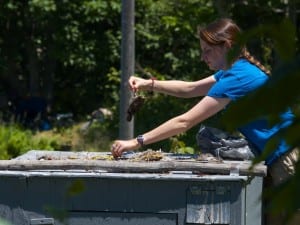
Peregrine falcon restoration program intern Claire Hartl feeding quail to peregrine falcons in Shenandoah National Park: Glynn Wilson
In between my taking photos and Claire’s note taking, we talked about the park’s Department of Natural Resources falcon restoration program.
In the Eastern U.S., peregrine populations declined drastically between the 1940s and ’60s due to the widespread spraying of DDT, a chemical pesticide used mainly to kill mosquitoes and prevent the spread of malaria. After the publication of the book Silent Spring by Rachel Carson in the early 1960s, scientists figured out that DDT damaged reproduction in peregrines and other birds like eagles, hawks and pelicans due to egg-shell thinning, egg breakage and hatching failure.
After DDT was banned by the new Environmental Protection Agency in 1972, and the peregrine was placed on the Endangered Species list in 1973, Cornell University (later the Peregrine Fund), the U.S. Fish and Wildlife Service and other natural resource agencies began reintroducing peregrine falcons back into their native range.
In cooperation with the Center for Conservation Biology at the College of William and Mary and the Virginia Department of Game and Inland Fisheries, the plan in Shenandoah is to hack and release 9-12 peregrine falcons near Hogback Mountain between May 5 and July 14. Hacking is the practice of taking young raptors and caring for them by feeding and protecting them until they are mature enough to be released back into their natural habitat. The goal is to get them to imprint in the area and return to breed in subsequent years.
The “foster” peregrine chicks used for this are removed from coastal bridge nests in Virginia, where fledgling survival has been low due to premature fledging over open water.
“Our goal for this project is to help restore peregrine falcon populations in the Central Appalachians (Virginia, West Virginia, and Maryland) where peregrine recovery has been slow,” the park service says on a Web page dedicated to the program. “In addition, using at risk Virginia coastal peregrines as hacking stock serves the dual purpose of improving the survival of these young peregrines while restoring peregrines to the mountains of Virginia. This restoration work directly supports the conservation and long-term recovery efforts of state-threatened peregrine falcons in the park and throughout Virginia.”
The restoration site or hacksite is near Hogback Mountain in an area that is temporarily closed to the public.
In previous years, from 2000-2014, the park released 121 peregrines from Hawksbill Mountain, Black Rock Summit, Franklin Cliffs, and the Hogback power line right-of-way. As far as scientists can tell, 112 of those successfully fledged. Nesting pairs have been documented returning to Stony Man and Old Rag between 2005 and 2014.
Peregrine falcons [falco peregrinus], also known as duck hawks or the “falcon wanderer,” are found throughout the world except Antarctica and have been very popular throughout history. They were prized during medieval times for their hunting prowess in the sport of Falconry. They continue to capture the fascination of many people due to their flight skills, hunting ability and mystique.
They are about the fastest member of the animal kingdom, and have been recorded flying more than 200 miles per hour as they “stoop” in a high speed dive to attack prey, mostly smaller birds like quail and shorebirds. In urban areas, they feed on pigeons, starlings, grackles and other medium-sized birds. In the Appalachians, they have been known to go after flickers, blue jays, towhees, juncos and mourning doves. They have been used to help control pigeon populations in New York, Washington, D.C., Chicago, London and other cities.
Between 1975 and 1993, more than 1200 young falcons were released throughout the East by regional peregrine falcon recovery teams. From 1978 to 1993 approximately 250 of those falcons were released in Virginia, according to the National Park Service. In 1980, peregrine falcons nested successfully in Virginia for the first time since DDT was banned.
Recovery has not been as successful as scientists had hoped, but the restoration program is making progress. Mainly due to their success in eastern coastal and urban areas, the peregrine falcon was removed from the Endangered Species List in 1999, yet it is still listed as “threatened” in Virginia and other states.
Adult peregrines are about the size of a crow with a wing span of about three feet. As with many raptors, females are larger than males. They reach nearly full size after only seven weeks.
Both genders have close to the same same coloration. In the first year, they are a chocolate brown with lighter streaks on the belly. Adults have slate blue backs and white with black speckling and salmon hues on the breast. Both sexes have distinctive black “side burns” under each eye.
In the wild, peregrines prefer high cliffs overlooking rivers, oceans and valleys where they build their nests. The nest is called a “scrape” which is often just a small depression in some gravel. Within the last 20 years, peregrines have increasingly nested on tall bridges, buildings, towers and other manmade structures in urban and coastal areas of the Eastern U.S.
Peregrines have been known to live as long as 15 years in the wild and somewhat longer in captivity. Their biggest natural enemy next to human development is the great-horned owl. More are killed when they run into large windows, utility lines and automobiles. They are also subject to contracting the West-Nile virus.
And of course some ignorant hunters have been known to shoot them. Law enforcement officials call this threat “illegal harvest.” If you witness this happening, you can report it to local law enforcement officials, including law enforcement rangers with the National Park Service.
Watch the Video
More Photos
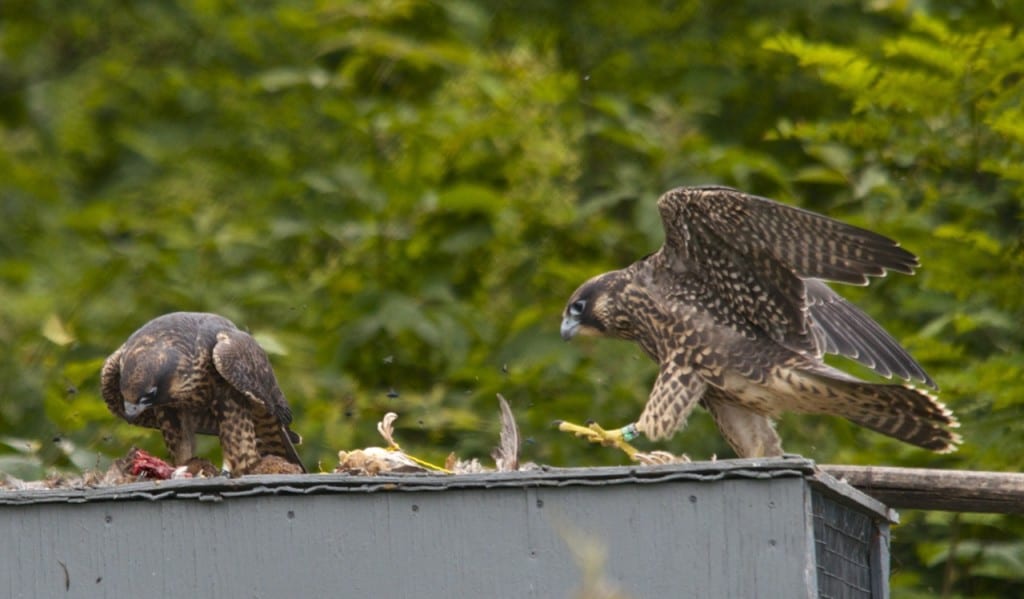
A group of peregrine falcons feeding on quail on Hogback Mountain in Shenandoah National Park: Glynn Wilson


